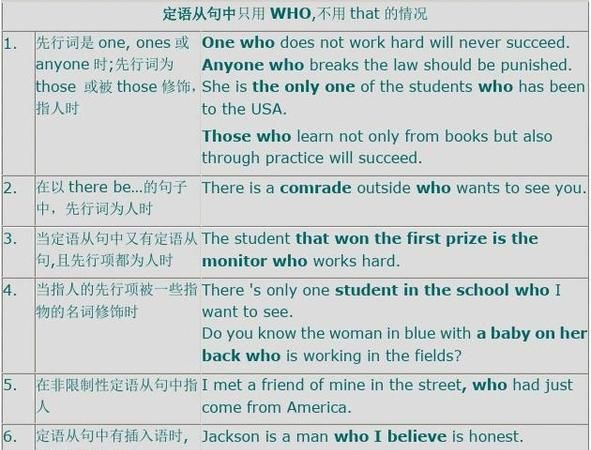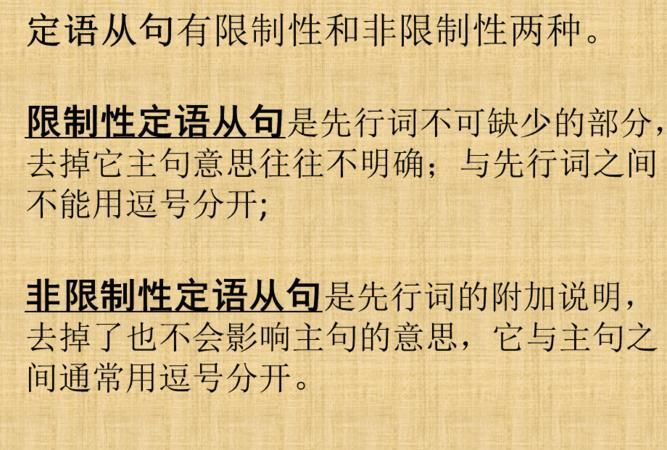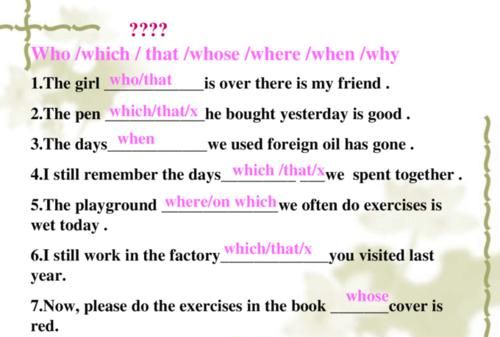本文目录
请大家帮忙转发朋友圈的话
定语
定语用来限定、修饰名词或代词的。充当定语的有:形容词、代词、名词、分词、介词短语或副词和从句.
定语一般用在所修饰词前,当然也存在后置的,如从句,对所修饰词期限定或修饰作用。
all students go to school
all作students的定语,起限定作用,意思是“所有的”学生都去学校,而不是“一部分”。
我(蓝天下漫步的羊)也来谈“定语”:
在英语句子中修饰名词,代词或其它名词化了词的句子成分叫定语。
充当定语的有:形容词、代词、名词、分词、介词短语或副词和从句.
定语的位置一般有两种:用在所修饰词之前的叫前置定语,用在所修饰词之后的叫后置定语。
单词作定语时通常放在它所修饰的词之前,作前置定语。短语和从句作定语时则放在所修饰的词之后,作后置定语。
1)定语前置
在英语里,一般定语前置时的次序为:限定词,形容词、分词、动名词和名词性定语。但当几个形容词同时出现在名词短语之前,我们要注意其次序。其形容词遵循的词序为:限观形龄色国材,指:限定词(一般指数量);外观(美丽等);形状(大小,高矮,肥瘦);年龄;颜色;国籍;材料;用途。如:
a famous American university
an interesting little red French oil painting
a new plastic bucket
purple velvet curtains
an elegant German clock
另外,有些形容词也有特殊的次序:
1) 描述身体特征的形容词先于表示情感和性格特征的形容词
例如:a small lovely girl , a long patient queue , a pale anxious patient ;
2) 表示颜色的形容词放在表示情感和性格特征的形容词之后
例如:a kindly black teacher ,an inquisitive brown dog ;
3) little ,old 和young 有时可以作为名词短语不可分割的一部分,所以可以直接放在名词之前,例如:a lovely little girl 表示性格特征的形容词可以放在old young 之前,也可放在old young 之后,例如:a young ambitious man (强调年龄) ,an ambitious young man(强调雄心勃勃) 。当然,三个以上形容词连用作定语,就显得累赘,因此上面所说的情况一般较少出现.
2)定语后置(1)短语作定语一般后置
It was a conference fruitful of results. 那是一个硕果累累的会议。
He gave me a basket full of eggs. 他给我一个装满鸡蛋的篮子。
English is a language easy to learn but difficult to master. 英语是一门容易学但是难精通的语言。
The boys hardest to teach are all in his class.最难教的男生都在他的班里了。
(2)修饰some,any,no,every等词构成的不定代词的定语都后置
Let’s go somewhere quiet. 咱们去找个安静一点的地方吧。
There is nothing important in today’s paper. 今天报纸上没有什么重要的东西。
Do you have anything more to say? 你还有什么话要说吗?
(3)副词作定语
The people here are very friendly. 这里的人很友好。
They lived in the room above.他们住在楼上的房间。
(4)动词、名词转化而来的以-able,-ible 结尾的形容词作定语
He is a person dependable. 他是一个可以依靠的人
This is the only transportation means available. 这是唯一可行的交通工具。
(5)起强调用的单个分词
Everybody involved should stay here.
The college mentioned.
3. 定语从句
英语里有大量的定语从句,而汉语里却没有定语从句的说法。英语中定语从句中甚至还可能包含定语从句,即多重定语从句。如: A healthy diet includes enough but not too many kinds of foods that provide the body with the nutrients that it needs to function properly. (健康的饮食包括的食物应该充足但又不过多。这些食物提供身体正常活动所必需的营养)
1)英语的复合句中,分句以其主句为基干,通过连接手段,一层一层地展开,就好像一棵树的树干上长出大枝子,大枝子上再长出小枝子。汉语的分句则更多按照时间发生的顺序出现,依次展开。
如: “伟大领袖和导师毛主席领导中国共产党进行了艰苦卓绝的斗争,建立了新中国,人民得到了解放,科学得到了解放。”这句话,译成英语便成了With the founding of new China (which was) born of arduous struggles (which were) waged by the Chinese Communist Party (which was) under the leadership of our great leader and teacher Chairman Mao , our people , and science as well , won emancipation.(王良兰,2003)
2)英语中的非限制性定语从句所表达的信息,在汉语里一般由另一个小句来表达。
例如:She asked for his help which he gladly gave. 她要求他帮忙,他愉快地帮助了她。
再如: It was a century during which the country suffered continuously from wars.
一个世纪过去了,在这期间这个国家不断遭受战乱之苦。

定语从句语法
一. 定语从句的概念
用一个主谓结构完整的句子作定语(定语的两种形式adj+n/n+定语从句),修饰前面的名词,代词,短语,甚至是整个句子的从句。简单来说就是把从句放在某个单词/词组/句子后面来对其进行修饰。
二. 两个首先必须明确的概念: 先行词和关系词
Kung Fu Panda is the best cartoon movie (先行词) that/which (关系词) I have watched this year.
注意:先行词未必永远都是定语从句之前的那一个单词,有的时候先行词与定语从句之间插入了别的成份,这个时候就必须通过上下文意思来寻找先行词。
(阅读) There has been a significant increase in the number of women with dependent children who are in the paid workforce in Australia.
Q: Which group of people has seen a significant increase in number in Australia?
三. 定语从句的分类
定语从句可以分为限制性定语从句和非限制性定语从句两大类。
限制性定语从句: England was one of the first countries where scientists adopted and publicized Copernican ideas (哥白尼学说) with enthusiasm.
(剑桥5 Test2 Reading Passage3)
(阅读) One new keyboard included keys which produced letters which frequently occur together in English, like –ing and –th and –ed, so the word “thing” would take two strokes to write instead of five.
特点: (1). 从句对先行词起限制作用,说明先行词必须如此,不能超出这个限制。先行词往往属于“集合”而非“元素”,并且它所表示的内容往往与先行词关系密切,必不可少。少了它,句子往往就会成为一句废话。
(2). 关系词引导的定语从句和先行词之间绝对没有逗号隔开。
非限制性定语从句: Such expansion, which was to take the English language west to America and east to India, was supported by scientific developments such as
the discovery of magnetism(磁力).
(阅读) It is very likely that the key board, which we have used for over a century, will soon be replaced by voice-activated computers which take dictation (听写) as we speak to them.
Tip: 在阅读中,遇到__________________定语从句可以先忽略不看,先看句子的主干。
特点: (1). 非限制性定语从句往往是对先行词(一般为“元素”)作进一步的解释和补充说明。如果把非限制性定语从句从句子中去掉,整个句子的意思不会受到很大影响。
(2). 关系词引导的定语从句和先行词之间绝对有逗号隔开。
The metal industry was established at Riverside Village by __________ who lived in the area.
定语从句和先行词之间有没有逗号,会直接决定句子意思的不同。试比较以下两个句子意思的不同:
1. In terms of exceptions, scientists refer to the waves which are too small individually to consider.
2. In terms of exceptions, scientists refer to the waves, which are too small individually to consider.
(写作)不少人认为如今被人们广泛使用的电脑未来总有一天将会彻底取代电视机。
Quite a number of people believe that televisions will be replaced by computers___
_______________________________________________________________________________注意:这个句子必须用____________________定语从句表示。由此看出在雅思写作和口语中描述事务的特性往往用它来表示。
四. 不同关系词的用法
1. 关系代词which的用法
(口语) What is your favorite spare time activity?
I usually choose to relax myself by watching American TV series in my spare time, ______________________________________________________________________________.
(口语) Do young people in your country live by themselves or with their parents?
As far as I know, many people of my age live with their parents not because they want to but because they have to. ______________________________________________
_______________________________________________________________________________
(口语) What leisure activities are popular in your country?
______________________________________________________________________________________________________________________________________________________________
由which引导的非限制性定语从句,其先行词对应的不仅可以是一个词或短语,也可以是主句的一部分甚至一个完整的句子。而在限制性定语从句中which就绝对不能用于修饰一个句子。
例句:(口语) My brother is a book-worm, when deeply absorbed in his books, which
he often is, he will forget about everything.
(口语) I am quite an outgoing person, which my brother is not.
(阅读) Fathers spend less time in housework and childcare, which is regarded by some scientists as a major contributor to the stress-related anxiety of employed
mothers.
(写作) 要解决交通问题,我们首先要解决的第一个问题就是日益增加的私车数量,我认为这是造成交通问题的最主要原因。
To solve the traffic problem, ___________________________________________________
_______________________________________________________________________________
2. 由who/whom/whose引导的定语从句
用法:当关系代词在定语从句中作主语时用who,作宾语,表语时用whom,表示所属关系时用whose。 它们所引导的定语从句既可以是限制性定语从句也可以是非限制性定语从句。
(口语) Describe your idol.
My idol is Jay,________________________________________________________________.
My idol is Jay, ________________________________________________________________.
My idol is Jay, ________________________________________________________________.
(口语) Describe a person that you respect the most.
我的父亲是一个教了30多年书的教师,他是我最尊敬的人。
______________________________________________________________________________________________________________________________________________________________
(口语) (1) Rain is a Korean Singer. (2). I appreciate him very much. (3). His popularity is second to none in Asia.
______________________________________________________________________________________________________________________________________________________________
3. 关系词when的用法
When引导的定语从句通常用在表示时间的名词或短语如time, year, day后面,它引导的定语从句既可以是限制性也可以是非限制性定语从句。
例句: (口语) Describe an important Chinese festival.
Spring Festival is the time when all the family members come back home and get together in China. (限制性定语从句)
In China, the most important traditional festival is Spring Festival, when all the family members would come back home and get together. (非限制性定语从句)
错误观念:凡是先行词是time/day等时间概念,关系词就一定是when。
(1). 我永远忘不了我第一次见到她的那一天。
I will never forget the day when I met her for the first time.
(2). 我永远忘不了我在上海和她度过的那些日子。
I will never forget the days when I spent with her in Shanghai. (X)
练习: (口语) Describe a day that is special to you.
______________________________________________________________________________________________________________________________________________________________
(口语) At what age do people in your country get married?
______________________________________________________________________________________________________________________________________________________________
4. 关系词where的用法
关系词where引导的定语从句通常用在表示地点的名词或短语后,如place, the city等。
它引导的定语从句既可以是限制性的也可以是非限制性的。
例句:(阅读)Nylon is a very tough synthetic fiber (人造纤维) first developed in the 1930s, and bearing a name to remind the hearer of the two places where it was developed: NY for New York and Lon for London.
(阅读) The power plants are usually located outside the city, where air quality problems are less serious.
(口语) Do you spend your free time with other people?
Yes. Sometimes I would invite my friends to have a cup of coffee in Starbucks, ____
_______________________________________________________________________________
(口语) Talk about a shopping center you are familiar with.
_______________________________________________________________________________
_______________________________________________________________________________
五. 定语从句的变形形式
1. be动词定语从句的变形
如果关系词which/who/that在定语从句中做主语,后面跟的谓语动词是be动词,则可以将关系词和be动词一起省略。这种用法在雅思阅读和写作中非常普遍。
(阅读/剑6Test3 Reading Passage3) Scientists are seeking a drug (which is) able to prolong life.
2. 实义动词定语从句的变形
关系词which/who/that在定语从句中作主语且紧跟在其后的谓语动词为实义动词时,可以省略关系词,此时谓语动词变为ing分词。
(剑5/Test4/Task2) Research, relating to identical twins, has highlighted (突显出) how significant inherited characteristics can be for an individual’s life.
定语从句变形形式的特点:(1). 只能用于关系词在定语从句中作主语的情况。
(2). 特别适合用于多重定语从句

并列定语从句和多重定语从句
He is a man who means what he say .
This is the place where the accident took place last night .
Is there anyone in your department whose father is a painter?
上面的不是非限定性定语从句,下面是限制性定语从句
Boys who attend this school have to wear uniforms .
Those who want to go please sign their names here .

关于定语从句的问题
which 或 that
形容词作定语:
The little boy needs a blue pen.(little修饰名词boy;blue修饰名词pen.)/小男孩需要一支蓝色的钢笔。
Tom is a handsome boy./Tom是个英俊的男孩。
There is a good boy./有个乖男孩。
数词作定语相当于形容词:Two boys need two pens./两个男孩需要两支钢笔。
The two boys are students./这两个男孩是学生。
There are two boys in the room./房间里有两个男孩。
代词或名词所有格作定语:
His boy needs Tom\'s pen./他的男孩需要Tom的钢笔。
His name is Tom./他的名字是汤姆。
There are two boys of Toms there./那儿有Tom家的两个男孩。
介词短语作定语:
The boy in the classroom needs a pen of yours./教室里的男孩需要你的一支钢笔。
The boy in blue is Tom./穿蓝色衣服的孩子是汤姆。
There are two boys of 9,and three of 10./有两个9岁的,三个10岁的男孩。
名词作定语:
The boy needs a ball pen./男孩需要一支圆珠笔。
It is a ball pen./这是一支圆珠笔。
There is only one ball pen in the pencil box./这铅笔盒里只有一支圆珠笔。
副词作定语:
The boy there needs a pen./那儿的男孩需要一支钢笔。
The best boy here is Tom./这里最棒的男孩是Tom。
不定式作定语:
The boy to write this letter needs a pen./写这封信的男孩需要一支钢笔。
The boy to write this letter is Tom./将要写这封信的男孩是汤姆。
There is nothing to do today./今天没有事要做。
分词(短语)作定语:
The smiling boy needs a pen bought by his mother./那个微笑的男孩需要一支他妈妈买的钢笔。
The pen bought by her is made in China./她买的笔是中国产的。
There are five boys left./有五个留下的男孩。
定语从句:
The boy who is reading needs the pen which you bought yesterday./那个在阅读的男孩需要你昨天买的钢笔。
The boy you will know is Tom./你将认识的男孩叫汤姆。
There are five boys who will play the game./参加游戏的男孩有五个。
定语的位置一般有两种:用在所修饰词之前的叫前置定语,用在所修饰词之后的叫后置定语。
单词作定语时通常放在它所修饰的词之前,作前置定语。短语和从句作定语时则放在所修饰的词之后,作后置定语。
1)定语前置
在英语里,一般定语前置时的次序为:限定词,形容词、分词、动名词和名词性定语。但当几个形容词同时出现在名词短语之前,我们要注意其次序。其形容词遵循的词序为:限观形龄色国材,指:限定词(一般指数量);外观(美丽等);形状(大小,高矮,肥瘦);年龄;颜色;国籍;材料;用途。如:
a famous American university
an interesting little red French oil painting
a new plastic bucket
purple velvet curtains
an elegant German clock
另外,有些形容词也有特殊的次序:
1) 描述身体特征的形容词先于表示情感和性格特征的形容词
例如:a small lovely girl , a long patient queue , a pale anxious patient ;
2) 表示颜色的形容词放在表示情感和性格特征的形容词之后
例如:a kindly black teacher ,an inquisitive brown dog ;
3) little ,old 和young 有时可以作为名词短语不可分割的一部分,所以可以直接放在名词之前,例如:a lovely little girl 表示性格特征的形容词可以放在old young 之前,也可放在old young 之后,例如:a young ambitious man (强调年龄) ,an ambitious young man(强调雄心勃勃) 。当然,三个以上形容词连用作定语,就显得累赘,因此上面所说的情况一般较少出现.
2)定语后置(1)短语作定语一般后置
It was a conference fruitful of results. 那是一个硕果累累的会议。
He gave me a basket full of eggs. 他给我一个装满鸡蛋的篮子。
English is a language easy to learn but difficult to master. 英语是一门容易学但是难精通的语言。
The boys hardest to teach are all in his class.最难教的男生都在他的班里了。
(2)修饰some,any,no,every等词构成的不定代词的定语都后置
Let’s go somewhere quiet. 咱们去找个安静一点的地方吧。
There is nothing important in today’s paper. 今天报纸上没有什么重要的东西。
Do you have anything more to say? 你还有什么话要说吗?
(3)副词作定语
The people here are very friendly. 这里的人很友好。
They lived in the room above.他们住在楼上的房间。
(4)动词、名词转化而来的以-able,-ible 结尾的形容词作定语
He is a person dependable. 他是一个可以依靠的人
This is the only transportation means available. 这是唯一可行的交通工具。
(5)起强调用的单个分词
Everybody involved should stay here.
The college mentioned.
(6)特殊词
Could you tell me something imporpant.
3. 定语从句
英语里有大量的定语从句,而汉语里却没有定语从句的说法。英语中定语从句中甚至还可能包含定语从句,即多重定语从句。如: A healthy diet includes enough but not too many kinds of foods that provide the body with the nutrients that it needs to function properly. (健康的饮食包括的食物应该充足但又不过多。这些食物提供身体正常活动所必需的营养)
1)英语的复合句中,分句以其主句为基干,通过连接手段,一层一层地展开,就好像一棵树的树干上长出大枝子,大枝子上再长出小枝子。汉语的分句则更多按照时间发生的顺序出现,依次展开。
如: “伟大领袖和导师毛主席领导中国共产党进行了艰苦卓绝的斗争,建立了新中国,人民得到了解放,科学得到了解放。”这句话,译成英语便成了With the founding of new China (which was) born of arduous struggles (which were) waged by the Chinese Communist Party (which was) under the leadership of our great leader and teacher Chairman Mao , our people , and science as well , won emancipation.(王良兰,2003)
2)英语中的非限制性定语从句所表达的信息,在汉语里一般由另一个小句来表达。用非限制性定语从句时,前应加逗号,并且非限制性定语从句引导词只能用which,不能用that。

以上就是关于多重定语从句例句 ,请大家帮忙转发朋友圈的话的全部内容,以及多重定语从句例句 的相关内容,希望能够帮到您。
